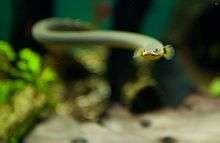Reedfish
| Reedfish | |
|---|---|
 | |
| Scientific classification | |
| Kingdom: | Animalia |
| Phylum: | Chordata |
| Class: | Actinopterygii |
| Subclass: | Chondrostei |
| Order: | Polypteriformes |
| Family: | Polypteridae |
| Genus: | Erpetoichthys J. A. Smith, 1865 |
| Species: | E. calabaricus |
| Binomial name | |
| Erpetoichthys calabaricus J. A. Smith, 1865 | |
| Synonyms | |
|
Calamoichthys calabaricus | |
The reedfish, ropefish (more commonly used in the United States), or snakefish, Erpetoichthys calabaricus, is a species of freshwater fish in the bichir family and order. It is the only member of the genus Erpetoichthys. It is native to West and Central Africa. The reedfish possesses a pair of lungs in addition to gills, allowing it to survive in very oxygen-poor water. It is threatened by habitat loss through palm oil plantations and urban development.
Description
The reedfish reaches a maximum total length of 37 cm (15 in). It has an eel-like, elongated body without a trace of a ventral fin. The long dorsal fin consist of a series of well-separated spines, each supporting one or several articulated rays and a membrane. The reedfish possesses a pair of lungs, enabling it to breathe atmospheric air. This allows the species to survive in water with low dissolved oxygen content and to survive for an intermediate amount of time out of water. Larvae have conspicuous external gills, making them resemble salamander larvae.[2]
The genus name derives from the Greek words erpeton (creeping thing) and ichthys (fish).[3]
Distribution and habitat
The reedfish inhabits slow-moving or standing, brackish or fresh, warm water at temperatures of 22–28 °C (72–82 °F). It occurs in Benin, Cameroon, Nigeria and possibly the Republic of the Congo, spanning the area from the Ogun River to the Chiloango River.[2]
Ecology
The reedfish is nocturnal, and feeds on annelid worms, crustaceans, and insects.[2] When moving through water slowly, it tends to use its pectoral fins, changing to an eel-like form of swimming (making more use of full-body movements and the caudal fin) when moving quickly. Both in the wild and in captivity, reedfish are known to explore land if given the opportunity, slithering along like a snake and also taking food items on land.[4]
Females repeatedly deposit small batches of eggs between the anal fins of the male, where they are fertilized. The male reedfish then scatters the eggs among aquatic vegetation, where they stick to plants and substrate. Larvae hatch rapidly (after 70 hours) but remain attached to vegetation; they become independent and start to feed after ~22 days, when the egg's yolk sac has been consumed.[2]

Conservation
In coastal central Africa, the species is threatened by habitat loss, driven by the development of oil palm plantations. Populations in western Africa are impacted by degradation and loss of habitat degradation from wetland drainage for agricultural and urban developments. The reedfish is currently classified as Near Threatened by the IUCN.[1]
In the aquarium
Reedfish are sometimes displayed in aquaria. They are inquisitive, peaceful, and have some "personality". Since they have a peaceful nature, other fish may "bully" a reedfish, despite its large size, especially in competition for food or space. Although nocturnal, reedfish will sometimes come out during the day, and this can be encouraged by daytime feeding of bloodworms or nightcrawlers for larger fish. Some reedfish also have an inclination to stay close to the water surface, where they will be safe from other fish and will even allow most of their bodies to leave the water at times. Though considered peaceful, they will often consume other smaller fish when given the opportunity. Often small feeder goldfish and minnows are eaten in place of bloodworms and other commercially available live fish food.
See also
References
- 1 2 Lalèyè, P., Moelants, T. & Olaosebikan, B.D. (2010). "Erpetoichthys calabaricus". IUCN Red List of Threatened Species. IUCN. 2010: e.T182479A7895183. Retrieved 11 February 2016.
- 1 2 3 4 Froese, Rainer and Pauly, Daniel, eds. (2014). "Erpetoichthys calabaricus" in FishBase. March 2014 version.
- ↑ Fishelson, L. (1984). Zoology. 2. Israel: Hakibutz Hameuchad Publishing House. p. 126.
- ↑ Pace, Cinnamon M.; Gibb, Alice C. (2011-02-15). "Locomotor behavior across an environmental transition in the ropefish, Erpetoichthys calabaricus". Journal of Experimental Biology. 214 (4): 530–537. doi:10.1242/jeb.047902. ISSN 0022-0949. PMID 21270300.
